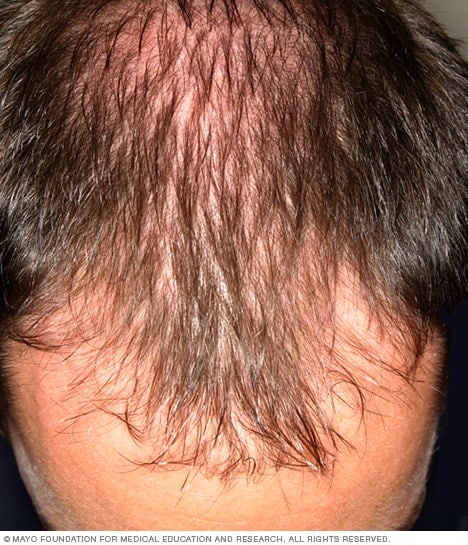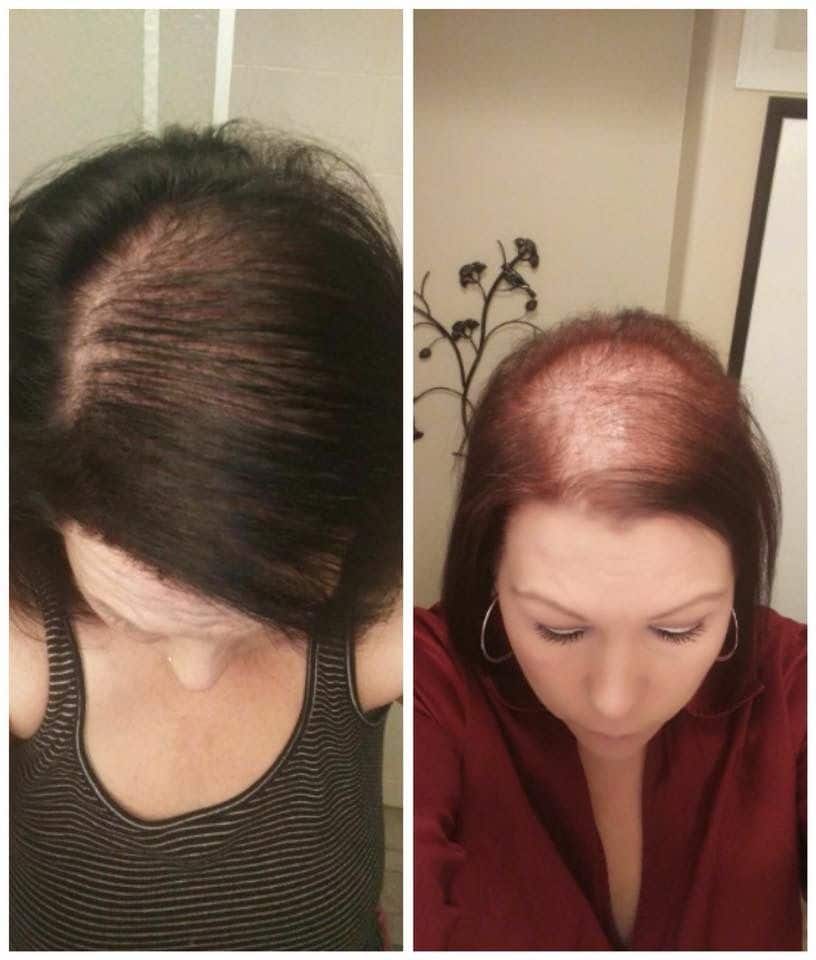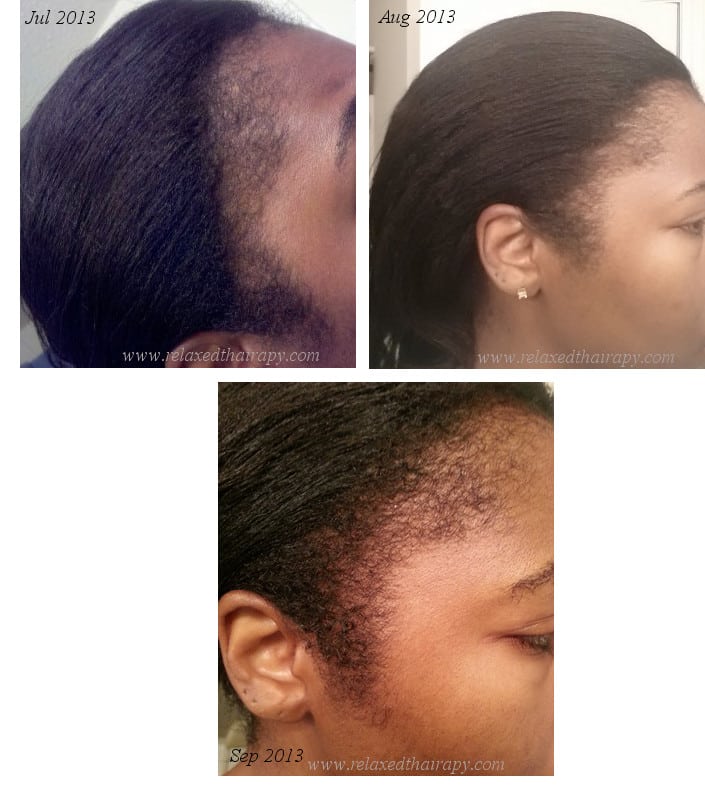Treatment For Female Pattern Baldness
Female pattern baldness or androgenetic alopecia, cannot be cured, however it can be managed in the short-term with the use of minoxidil. Minoxidil is a foam or lotion that must be rubbed into the scalp once or twice a day. Minoxidil must be used for a period of several months in this way before any effect can be seen. When you stop using minoxidil, you can expect hair loss to resume within a few months.
Minoxidil does not require a prescription it is sold over the counter under several different names, including Regaine. In one study, Regaine for women regular strength, which contains 2% minoxidil, stabilised hair growth/loss in 88% of women.
Minoxidil should only be used on the scalp, which means it is not appropriate for women seeking to treat hair loss elsewhere on their bodies.
Common Types Of Hair Loss
Androgenetic Alopecia
The old saying that baldness genes come only from your mothers side of the family simply isnt true. Baldness actually comes from both of your parents genetic makeup .
The most extensive and most common type of hair loss is androgenetic alopecia, which is genetic hair loss, and occurs in both men and women. In men, androgenetic alopecia is also referred to as male-pattern baldness where the hair recedes above the temples and the crown of the head. In women, this type occurs throughout the entire head, becoming thinner and thinner all over but rarely resulting in total baldness.
Alopecia Areata
Alopecia doesnt just affect adults. When younger kids or teens experience Alopecia Areata, they lose hair in a round formation due to an autoimmune issue. The hair is there, but its not growing correctly and is often very smooth and fine. The most common treatment for this condition is a steroid injection under the skin. Alopecia can cause someone to lose all of the hair on their head or across their entire body, depending on its severity.
Traction Hair Loss
Traction hair loss occurs most often in women and is generally very gradual. Its primary cause is the result of hair being pulled or tugged on repeatedly. For example, when someone wears their hair in a tight ponytail, braids, or other restricting hair styles. This condition can also be caused by someone chronically pulling their hair out. Telogen Effluvium
Next, lets dive into a few treatment options.
Female And Malepattern Baldness
You might already know about malepattern baldness, a type of hair loss caused by a combo of genes and male sex hormones that usually makes the hair on a mans head recede at the temples, leaving an Mshaped hairline.
But hormone-related hairloss for femalesor femalepattern baldnessis also a thing, according to the US National Institute of Health. This type of hair loss occurs when the hair follicle shrinks so much over time that it doesnt grow new hair. In women, the symptoms of femalepattern baldness includes a widening of the center hair part, and, sometimes, coarser hair on the face.
The only FDAapproved treatment for female and malepattern hair is minoxidil , but if that doesnt work, your healthcare provider may prescribe oral medications such as finasteride that can halt hair loss or even cause some to grow surgery to transplant or graft hair is also an option.
Read Also: What Vitamins For Female Hair Loss
You May Like: Can Shampoo Stop Hair Loss
Reasons For Hair Thinning
Your genes.These play a key role in male- or female-pattern baldness, which is a common part of aging. If youâre a woman, your hair may get thinner overall, but the condition isnât likely to make your hairline recede or bring on baldness. If youâre a man, your hair may thin near the top of your head, and youâre more likely to have a retreating hairline and balding.
Stress. Certain stressful events can make your hair look thinâsometimes a couple months after the stressful situation. Itâs a condition called telogen effluvium, and your hair usually grows back on its own. Triggers for stress-induced hair loss can include:
Chronic Or Acute Illness Or Disease

Any type of acute or chronic disease that causes significant inflammation can contribute to hair loss.
This includes acute infections accompanied by high fever and a variety of autoimmune conditions.
Theres even new evidence that COVID-19 can cause hair loss in some people.
The tricky thing about chronic diseases is we often dont realize we have one!
For example, Hashimotos produces little to no symptoms during the early stages, and there are plenty of people unknowingly living with inflammatory digestive issues, like intestinal permeability or Irritable Bowel Syndrome, which have also been shown to cause hair loss.
The takeaway: if you have mysterious hair loss along with any other symptoms, no matter how mild like fatigue, indigestion, etc., definitely get yourself checked out by a functional medicine physician.
Recommended Reading: Why Is My Hair Thinning In The Front
Style Tips For Thinning Hair
Ask your stylist. They might suggest a short cut, a different part, maybe a gentle body wave. Try a styling product for thin hair to hide bare spots. Apply it to the root area then gently blow dry to build volume. Let your hair air dry for a while before you use the dryer. Special cosmetics can disguise parts of your scalp that show. Think about keratin fiber hair cosmetics. Sprinkle them over the thinning patch. Their static charge makes hair look thicker.
Sudden Or Extreme Dietary Changes
Any time we change our diets radically, like drastically reducing calories or cutting out entire food groups, it has the potential to create enough stress and lack of nutrients to cause hair loss.
The most important thing is to use commonsense and always make sure any change in diet focuses on eating plenty of nutrient-dense foods. Generally, I do not recommend diets that demonize entire food groups, like carbs or vegetables or meat.
Its also important to use detox cleansing and fasting as short-term strategies for healingnot long-term lifestyle changes, as our microbiome diversity and overall health benefit from a wide variety of foods.
Don’t Miss: How To Prevent Hair Loss In Women
What Causes Hair To Thin
Any number of lifestyle factors, genetics, recent life events , or medical conditions can cause your hair to thin.
Lifestyle factors could include using certain hair products, wearing your hair up too tightly, experiencing high stress levels, or not getting enough of certain vitamins and minerals in your diet.
People who have immune system deficiencies could also have thinning hair.
Female Pattern Hair Loss
In women, hair slowly thins all over the scalp, but the hairline usually doesnt recede. Many women experience this type of hair loss as a natural part of aging, although hair loss may begin any time after puberty. Female pattern hair loss can cause hair to thin dramatically, but only rarely does it lead to baldness.
Recommended Reading: Does Lack Of Water Cause Hair Loss
Hair Transplants In Women
This illustration shows how follicles are harvested for a hair transplant to treat baldness in a technique called follicular unit extraction . Hair is shaved in an area on the head and then 1 to 4 hairs are removed. Those units and then are implanted into the bald area of the head. Results should begin to show within 6 to 9 months.
Thinning Crown Is No Longer A Worry With These Solutions
Hair has an important role in deciding ones appearance. According to a study about Social Communication, it is said that hair is one of the first things people will notice when they communicate with a person at their first meeting. Thats why having amazing hair can help you create a good first impression. Suddenly, on one beautiful day, balding comes and visits your life. We know that any kind of baldness is upsetting, you can be totally destroyed inside when suffering thinning hair or baldness on the crown which makes you feel anxious and embarrassed. Luckily, there are several ways to help you get out of thinning hair crown condition. Hairstyles, hair care products, and styling techniques are what you can try for your hair improvement.
As an expert in this field for many years, Layla will recommend some doable and effective solutions you can try for your thinning crown. Are you ready? Lets get started!
Also Check: Does Biotin Shampoo Help With Hair Loss
How Is Female Pattern Baldness Treated
The main aim of treatment is to slow down or stop hair loss. Treatment might also stimulate hair growth, but this kind of treatment works better for some women than others.
If you have female pattern baldness, your doctor might prescribe minoxidil, or a cream containing minoxidil. This active ingredient is found in lotions like Hair Revive Extra Strength, Hair Retreva, and Hair A-Gain. Its important to discuss the potential side effects of these treatments with your doctor.
There is not enough evidence to show that laser treatments, plasma injections, hair tonics and nutritional supplements will stimulate hair growth.
Thinning Hair And Hair Loss: Could It Be Female Pattern Hair Loss

For most women, FPHL begins in midlife, when a woman is in her 40s, 50s, or 60s. It can begin earlier for some women.
FPHL is a progressive condition. This means women tend to continue losing hair. But women do not lose all of their hair, as do some men. Instead, your part often gets wider. Hair near your temples may recede. Without treatment, some women eventually develop widespread thinning.
Treatment can prevent hair loss from worsening and help women regrow their hair. Treatment delivers the best results when started at the first sign of hair loss.
Read Also: What Hair Color Hides Thinning Hair
Whats The Difference Between Hair Thinning And Receding
If your hair is thinning primarily on your frontal scalp versus the entire head, you may be dealing with a receding hairline. With a thinning hairline, its a reduction of hair fibers in each hair follicle, which creates the appearance of less density, Florida-based trichologist Bridgette Hill has told Cosmo. But with receding, its a reduction of actual hair follicles that become dormant and die off, leading to a higher hairline and the forehead becoming more obvious.
Just like hair loss and thinning, there are a number of factors that can contribute to a receding hairline , which is why its so important to meet with a dermatologist or trichologist who can assess your scalp and hair and give you a clear plan of action before you do an-y-thing.
What Is The Relationship Between Hair Loss In Women And Menopause
During menopause, you might see one of two things happen with your hair. You might start growing hair where you didnt before. Or, you might see the hair you have start to thin. One cause may be changing levels of hormones during menopause. Estrogen and progesterone levels fall, meaning that the effects of the androgens, male hormones, are increased.
During and after menopause, hair might become finer because hair follicles shrink. Hair grows more slowly and falls out more easily in these cases.
Your healthcare provider will do a thorough examination and take a detailed history to help you deal with changes in hair growth. You may be directed to have your iron levels or thyroid hormone levels tested. Your medications might be changed if what you take is found to affect hair loss or growth.
Recommended Reading: How To Use Minoxidil For Hair Loss
What Are The Causes And Types Of Female Pattern Baldness
Genetics usually plays a part in the development of female pattern baldness. A woman can inherit the genes that cause female pattern baldness from one or both of their parents. Its also possible that hormones contribute to the condition. For example, hair loss is a symptom of the hormonal condition, polycystic ovary syndrome.
Female pattern baldness is different from alopecia areata, which is an auto-immune disease resulting in hair loss from the scalp and other parts of the body.
Where To Seek Help
- The Australian Alopecia Areata Foundation provides material about alopecia areata, as well as information about support groups.
- Read more about polycystic ovarian syndrome and other womens health issues at Jean Hailes for Womens Health.
- Beyond Blue can help if you feel anxious or depressed, including as a result of hair thinning or loss. Call 1300 22 4636 anytime.
Recommended Reading: How To Stop Hair Thinning Men
Dandruff Or Scalp Psoriasis
When the skin on the scalp is inflamed and itchy, its obviously tempting to scratch it. But that may cause your hair to shed more than usual.
Dandruff is the most easily treated cause of hair loss, Dr. Fusco says, because you can treat it with over-the-counter products, like a shampoo containing zinc pyrithione or exfoliating ingredients such as the classic Head & Shoulders Classic or Oribe Serene Scalp Anti-Dandruff Shampoo . “Consistency is the trick,” Dr. Fusco says, so it’s important to find a shampoo and conditioner you like enough to use regularly.
But other conditions can also cause itchiness and scalp flaking, including seborrheic dermatitis and psoriasis . Treating these issues may take more time and effort than dandruff, so its important to check in with a dermatologist if you think you may be dealing with one of these conditions.
Iron Deficiency/anemia Hair Loss
“One of the most common causes of hair loss in women is an iron deficiency. Iron is essential for producing hair cell protein”, without it, your strands will suffer says Anabel. If in doubt, it’s best to speak to your GP for advice regarding an iron deficiency, as they may recommend a blood test to confirm the correct treatment.
You May Like: What Can I Do To Stop Thinning Hair
My Hair Thinning Is Getting Pretty Bad At The Moment And Am Wondering How To Deal With The Next Stage If It Doesn’t Grow Back
So I am 47 with PCOS and have had thinning hair for 30 years. Luckily I had fine hair but lots of it so for a lot of that time could disguise the thinning. I took spironolactone for 15 plus years and been on minoxidil 5% for I good 20 years I’d guess, both of which slowed things down for me, so that plus hair style changes, thickening shampoos etc were all I needed.
Now I’m still on these plus metformin recently added. But my hair thinning has suddenly gotten worse. It’s diffuse all over and hair styling is no longer hiding it.
So I’m wondering what next. I grew out my fringe it’s now too thin, was wearing my hair in a loose bun but I’ve now noticed the sides are very thin and bald. Like areas of no hair at all. My parting has increased and my head shines through most of my hair no matter what.
Part of me is really tempted to shave it all off but I don’t have the facial features to suit that.
I don’t know that I could cope with a wig, I guess I should try one on at least?
Hair scarves etc?
But also how do you deal with “coming out” to work and the rest of the world with this “new you” that’s what scares me the most. Any words of wisdom from anyone who has done this already?
What Does The Research Say

Hair loss can develop differently, depending on a persons sex. For example, the British Association of Dermatologists reports that female pattern hair loss typically affects people aged 30 or older and causes thinning of hair on the crown of the head. It also says that the hair may appear shorter in other areas. There is currently no cure.
A person might try home care strategies, but these should not replace professional treatment for an underlying health condition that may be causing thin hair, such as a nutritional deficiency or alopecia.
The natural remedies below may help thicken thin hair, regardless of whether further treatment is necessary.
You May Like: Does Lack Of Calcium Cause Hair Loss
Hair Loss Treatment For Women: Female Hair Loss Advice
Faced with thinning hair, many women will start researching the best hair loss treatments that may help stop the problem and promote regrowth. The problem is that, because hair loss is often caused by genetic factors or other health conditions, it can be difficult to know which treatment may work best for you.
For both men and women hair loss treatment tends to be complex, and requires ongoing attention and maintenance.
Coping With Hair Loss
While losing hair at a young age may be concerning, hair loss is a reality for many people as they age. One study posted to the Indian Journal of Dermatology, Venereology, and Leprology noted that up to 75% of females would experience hair loss from androgenetic alopecia by the time they are 65 years old.
While many females look for ways to treat hair loss while they are young, at some point, most people accept hair loss as a natural part of the aging process.
Some people may choose to wear head garments or wigs as a workaround to hair loss. Others work with their aging hair by wearing a shorter haircut that may make thin hair less apparent.
Don’t Miss: Does Finasteride Stop Hair Loss
How Is Female Pattern Baldness Diagnosed
Talk to your doctor if your hair is thinning. Your doctor will examine your hair and scalp, and might refer you to a dermatologist, a doctor who specialises in skin problems.
If you have acne, irregular periods or a lot of body hair, your doctor might recommend a test to check your hormones, or to rule out polycystic ovarian syndrome.
They might also recommend removing a tiny piece of skin from your scalp to test for hair loss conditions such as alopecia areata.